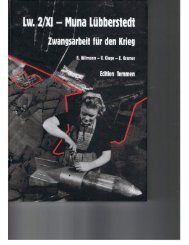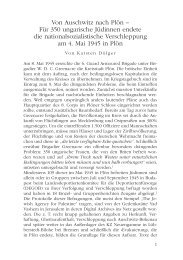The Kallos Family Book 2022
Always remember and tell the story to the world
Always remember and tell the story to the world
- TAGS
- barbara lorber
You also want an ePaper? Increase the reach of your titles
YUMPU automatically turns print PDFs into web optimized ePapers that Google loves.
PART 1: THE KALLOS FAMILY • 29
a German seaside resort on the Bay of Lübeck
that was converted into a displaced persons
(DP) camp, where they were able to recover
their strength. German residents of Haffkrug
were forced to leave their luxury holiday homes,
which were handed over to survivors. Many
survivors made clothing for themselves from
blankets and curtains that hung in the homes
just so they could feel more human again.
Haffkrug DP camp
After Biri Kallos recovered her health, and due to
her ability to speak English and Czech, she was
accepted as a volunteer with the British army to
help collect details of the survivors and to prepare
transports for their return home. Every day for
two months Biri attended the British army’s militook
about two weeks: it was a death march on
wheels. The bodies of those who died from starvation
and illness en route were thrown off the
train. The train was bombed by the Royal Air
Force (RAF), who erroneously believed it carried
only Nazis. Just days before the war ended the
RAF made two direct hits, both of them blood
baths that killed about sixty-two Jewish female
prisoners and injured many others. Some young
women lost limbs.
It’s a miracle that the three family groups
from Ťačovo all survived, especially the three
mothers – Lili, Berta and Gizella.
The survivors, by now in a deplorable state,
were finally liberated by the British in Plön,
Germany, on 8 May 1945 and taken to Haffkrug,
Ickovic family survivors at Haffkrug DP camp,
Germany. Left to right: Malvina, the oldest
sister, Fritzi, the youngest, and Sheindy.
The clothes they are wearing are made from
blankets and curtains that hung in the Haffkrug
holiday home where they stayed. Fritzi’s skirt
was made from curtains.
PHOTO FROM USC HOLOCAUST FOUNDATION.
Left to right: Barbara Tabak, Lili Kallos and
Barbara Kallos outside their house in Haffkrug
DP camp. Their white dresses were made from
curtains that hung in their luxury German
accommodation.
PHOTO PROVIDED BY BARBARA KALLOS.





